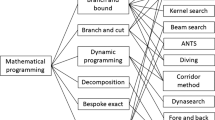Abstract
In order to solve linear programs with a large number of constraints, constraint generation techniques are often used. In these algorithms, a relaxation of the formulation containing only a subset of the constraints is first solved. Then a separation procedure is called which adds to the relaxation any inequality of the formulation that is violated by the current solution. The process is iterated until no violated inequality can be found. In this paper, we present a separation procedure that uses several points to generate violated constraints. The complexity of this separation procedure and of some related problems is studied. Also, preliminary computational results about the advantages of using multiple-points separation procedures over traditional separation procedures are given for random linear programs and survivable network design. They illustrate that, for some specific families of linear programs, multiple-points separation can be computationally effective.
Similar content being viewed by others
References
Astorino, A., Gaudioso, M.: Polyhedral separability through successive LP. J. Optim. Theory Appl. 112 (2), 265–293 (2002)
Ben-Ameur, W., Neto, J.: Acceleration of cutting plane and column generation algorithms. 2003 (Submitted)
Ben-Ameur, W., Neto, J.: Multipoint separation. Research Report 04012 RS2M, Institut National des Télécommunications, Evry, France (2004)
Benders, J.F.: Partitioning procedures for solving mixed variables programming problems. Numerische Mathematik 4, 238–252 (1962)
Bennett, K.P., Mangasarian, O.L.: Robust linear programming discrimination of two linearly inseparable sets. Optim. Meth. and Software 1, 23–34 (1992)
Bosch, R.A., Smith, J.A.: Separating hyperplanes and the authorship of the disputed federalist papers. Amer. Math. Monthly 105 (7), 601–608 (1998)
Boyd, S., Vandenberghe, L.: Convex optimization. Cambridge University Press, 2004
Cheston, G.A., Fricke, G., Hedetniemi, S.T., Jacobs, D.P.: On the computational complexity of upper fractional domination. Discrete Appl. Math. 27, 195–207 (1990)
Chvátal, V.: Edmonds polytopes and a hierarchy of combinatorial problems. Disc. Math. 4, 305–337
CPLEX, CPLEX callable library, CPLEX Optimization, Inc
Dahl, G., Stoer, M.: A cutting plane algorithm for multicommodity survivable network design problems. INFORMS J. Comput. 10, 1–11 (1998)
Dahl, G., Stoer, M.: A polyhedral approach to multicommodity survivable network design. Numerische Mathematik 68, 149–167 (1994)
Garey, M.R., Johnson, D.S.: Computers and intractability. W.H. Freeman, New York, 1979
Geoffrion, A.M.: Generalized Benders decomposition. J. Optim. Theory and Appl. 10, 237–260 (1972)
Goffin, J.L., Vial, J.P.: Convex nondifferentiable optimization: a survey focussed on the analytic center cutting plane method. Optim. Meth. Software 17, 805–867 (2002)
Gomory, R.E.: Outline of an algorithm for integer solutions to linear programs. Bulletin of the American Mathematical Society 64, 275–278 (1958)
Grötschel, M., Lovasz, L., Schrijver, A.: Geometric Algorithms and Combinatorial Optimization. Springer, 1988
Iri, M.: On an extension of the maximum-flow minimum-cut theorem to multicommodity flows. J. Oper. Res. Soc. Japan 13, 129–135 (1971)
Jünger, M., Reinelt, G., Thienel, S.: Practical problem solving with cutting plane algorithms in combinatorial optimization. In: Cook, W., Lovasz, L., Seymour, P (eds.) Combinatorial optimization, DIMACS series in discrete mathematics and theoretical computer science, 1995 pp 111–152
Kelley, J.E.: The cutting-plane method for solving convex programs. J. SIAM 8, 11–152 (1960)
Khachiyan, L.G.: A polynomial algorithm in linear programming. Soviet Mathematics Doklady 20, 191–194 (1979)
Mangasarian, O.L.: Linear and nonlinear separation of patterns by linear programming. Oper. Res. 13 (3), 444–452 (1965)
Mangasarian, O.L., Setiono, R., Wolberg, W.W.: Pattern recognition via linear programming: theory and applications to medical diagnosis. In: Coleman, T.F., Li, Y (eds) Large-scale numerical optimization. SIAM, Philadelphia, 1990 pp 22–30
Mangasarian, O.L., Street, W.N., Wolberg, W.W.: Breast cancer diagnosis and prognosis via linear programming. Oper. Res. 43, 570–577 (1995)
Megiddo, N.: On the complexity of polyhedral separability. Disc. Comput. Geom. 325–337 (1988)
Minoux, M.: Network synthesis and optimum network design problems: Models, solution methods and applications. Networks, 19, 313–360 (1989)
Mitchell, J.E.: Interior point methods for combinatorial optimization. In: Terlaky, T. (ed.) Interior point methods in mathematical programming, Kluwer Academic Publishers, 1996
Mitchell, J.E., Borchers, B.: Solving linear ordering problems with a combined interior point/simplex cutting plane algorithm. Technical Report, Mathematical Sciences, Rensselaer Polytechnic Institute, Troy, NY 12180–3590, (1997)
Mitchell, J.E., Pardalos, P., Resende, M.G.C.: Interior point methods for combinatorial optimization. In: Du, D.-Z., Pardalos, P. (ed.) Handbook of combinatorial optimization Kluwer Academic Publishers, 1998
Nemhauser, G.L., Wolsey, L.A.: Integer and combinatorial optimization. John Wiley, New York, 1988
Nesterov, Y.: Cutting plane algorithms from analytic analytic centers: efficiency, estimates. Math. Prog. 56, 149–176 (1995)
Onaga, K., Kakusho, O.: On feasibility conditions of multicommodity flows in networks. Trans. Circ. Theory 4, 425–429 (1971)
Padberg, M., Rinaldi, G.: A branch-and-cut algorithm for the resolution of large-scale symmetric traveling salesman problems. SIAM Rev 33, 60–100 (1991)
Rosen, J.B.: Pattern separation by convex programming. J. Math. Anal. Appl. 10, 123–134 (1965)
Vaidya, P.M.: A new algorithm for minimizing convex functions over convex sets. Math. Prog. 73, 291–341 (1996)
Veinott, A.F.: The supporting hyperplane method for unimodal programming. Oper. res. 1, 147–152 (1967)
Ye, Y.: Interior-point algorithm: theory and analysis. John Wiley & Sons, 1997
Author information
Authors and Affiliations
Corresponding author
Rights and permissions
About this article
Cite this article
Ben-Ameur, W., Neto, J. A constraint generation algorithm for large scale linear programs using multiple-points separation. Math. Program. 107, 517–537 (2006). https://doi.org/10.1007/s10107-005-0694-0
Received:
Accepted:
Published:
Issue Date:
DOI: https://doi.org/10.1007/s10107-005-0694-0




